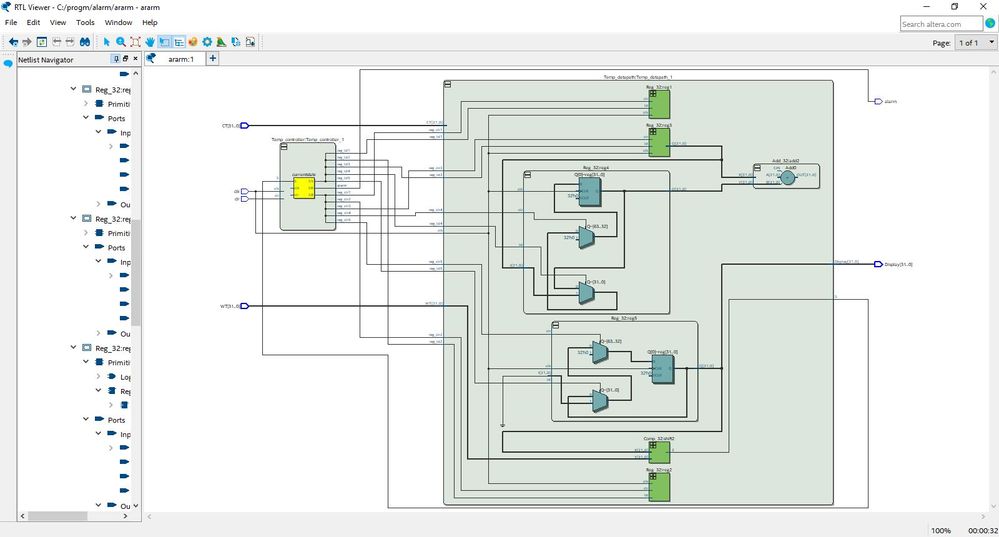- Mark as New
- Bookmark
- Subscribe
- Mute
- Subscribe to RSS Feed
- Permalink
- Report Inappropriate Content
module alarmsystem(clr,clk,alarm,CT,WT,Display);
input clk,clr;
input [31:0]CT;
input [31:0]WT;
output alarm;
output [31:0]Display;
wire reg_ld1,reg_ld2,reg_ld3,reg_ld4,reg_ld5;
wire reg_clr1,reg_clr2,reg_clr3,reg_clr4,reg_clr5;
wire S;
Temp_controller
Temp_controller_1(reg_ld1,reg_ld2,reg_ld3,reg_ld4,reg_ld5,reg_clr1,reg_clr2,reg_clr3,reg_clr4,reg_clr5,S,alarm,clr,clk);
Temp_datapath
Temp_datapath_1(reg_ld1,reg_ld2,reg_ld3,reg_ld4,reg_ld5,reg_clr1,reg_clr2,reg_clr3,reg_clr4,reg_clr5,clk,S,CT,WT,Display);
endmodule
module Reg_32(I,Q,clk,clr,ld);
input[31:0]I;
input clk,clr,ld;
output [31:0] Q;
reg[31:0]Q;
always@(posedge clk)
begin
if (clr)
Q<=32'b00000000000000000000000000000000;
else if (ld)
Q<=I;
else
Q<=Q;
end
endmodule
module Add_32(X,Y,Z);
input[31:0]X,Y;
output[31:0]Z;
assign Z=X+Y;
endmodule
module Shift_32(I,Z);
input[31:0]I;
output[31:0]Z;
assign Z=(I>>2);
endmodule
module Comp_32(X,Y,Z);
input[31:0]X,Y;
output Z;
reg Z;
always@(X or Y)
begin
//////Z<=0;
if(X<Y)
Z<=0;
else
Z<=1;
end
endmodule
module Temp_datapath(reg_ld1,reg_ld2,reg_ld3,reg_ld4,reg_ld5,reg_clr1,reg_clr2,reg_clr3,reg_clr4,reg_clr5,clk,S,CT,WT,Display);
input clk,reg_ld1,reg_ld2,reg_ld3,reg_ld4,reg_ld5,reg_clr1,reg_clr2,reg_clr3,reg_clr4,reg_clr5;
input [31:0]CT,WT;
output[31:0]Display;
output S;
wire[31:0]wire_1,wire_2,wire_3,wire_4,wire_5,wire_6,wire_7,wire_8;
Reg_32 reg1(CT,wire_1,clk,reg_clr1,reg_ld1);
Reg_32 reg2(wire_1,wire_2,clk,reg_clr2,reg_ld2);
Reg_32 reg3(wire_2,wire_3,clk,reg_clr3,reg_ld3);
Reg_32 reg4(wire_3,wire_4,clk,reg_clr4,reg_ld4);
Reg_32 reg5(h,Display,clk,reg_clr5,reg_ld5);
Add_32 add1(wire_1,wire_2,wire_5);
Add_32 add2(wire_3,wire_4,wire_6);
Add_32 add3(wire_5,wire_6,wire_7);
Shift_32 shift1(wire_7,wire_8);
Comp_32 shift2(Display,WT,S);
endmodule
module Temp_controller(reg_ld1,reg_ld2,reg_ld3,reg_ld4,reg_ld5,reg_clr1,reg_clr2,reg_clr3,reg_clr4,reg_clr5,S,alarm,clr,clk);
input clk,clr,S;
output reg_ld1,reg_ld2,reg_ld3,reg_ld4,reg_ld5;
output reg_clr1,reg_clr2,reg_clr3,reg_clr4,reg_clr5;
output alarm;
reg reg_ld1,reg_ld2,reg_ld3,reg_ld4,reg_ld5;
reg reg_clr1,reg_clr2,reg_clr3,reg_clr4,reg_clr5;
reg alarm;
parameter S0=4'b0000,S1=4'b0001,S2=4'b0010,S3=4'b0011,S4=4'b0100,S5=4'b0101,S6=4'b0110,S7=4'b0111,S8=4'b1000;
reg[4:0] currentstate;
reg[4:0] nextstate;
always@(posedge clk ) begin
if (clr ==1)
currentstate = S0;
else currentstate=nextstate;
end
//begin
//currentstate<=nextstate;
//end
always@(currentstate or S)
begin
alarm<=0;
reg_ld1<=0;
reg_ld2<=0;
reg_ld3<=0;
reg_ld4<=0;
reg_ld5<=0;
reg_clr1<=0;
reg_clr2<=0;
reg_clr3<=0;
reg_clr4<=0;
reg_clr5<=0;
case(currentstate)
S0:begin
nextstate<=S1;
end
S1:begin
nextstate<=S2;
end
S2:begin
nextstate<=S3;
end
S3:begin
nextstate<=S4;
end
S4:begin
nextstate<=S5;
end
S5:begin
reg_ld1<=1;
reg_ld2<=1;
reg_ld3<=1;
reg_ld4<=1;
reg_ld5<=1;
if(clr==1)
nextstate<=S0;
else if(S==1)
nextstate<=S6;
else
nextstate<=S7;
end
S6:begin
alarm<=1;
if(clr==1)
nextstate<=currentstate;
else
nextstate<=S8;
end
S7:begin
alarm<=0;
if(clr==1)
nextstate<=currentstate;
else
nextstate<=S8;
end
S8:begin
reg_clr1<=1;
reg_clr2<=1;
reg_clr3<=1;
reg_clr4<=1;
reg_clr5<=1;
nextstate<=S0;
end
endcase
end
endmodule
Link Copied
- Mark as New
- Bookmark
- Subscribe
- Mute
- Subscribe to RSS Feed
- Permalink
- Report Inappropriate Content
- Mark as New
- Bookmark
- Subscribe
- Mute
- Subscribe to RSS Feed
- Permalink
- Report Inappropriate Content
Use the RTL design process to create an alarm system that sets a single-bit output alarm to 1 when the average temperature of four consecutive samples meets or exceeds a user-defined threshold value (set your own threshold). A 32-bit unsigned input CT indicates the current temperature, and a 32-bit unsigned input WT indicates the warning threshold. Samples should be taken every 5 clock cycles. A single-bit input clr when 1 disables the alarm and the sampling process. Start by capturing the desired system behaviour as an HLSM, and then convert to a controller/datapath. Write your Verilog code and download your program into FPGA. Set LED as your alarm indicator.
- Mark as New
- Bookmark
- Subscribe
- Mute
- Subscribe to RSS Feed
- Permalink
- Report Inappropriate Content
i had a problem that my load input not connected to reg_ld...can u help me? 0166801697 this is my phone number.
- Mark as New
- Bookmark
- Subscribe
- Mute
- Subscribe to RSS Feed
- Permalink
- Report Inappropriate Content
Hi sisa,
I could able to compile & simulate the design provided over here.
please find the attachments for schematic & simulation results.
Try to compile & simulate at your end & provide specific error/issue if you have.

Regards,
Vikas Jathar
- Subscribe to RSS Feed
- Mark Topic as New
- Mark Topic as Read
- Float this Topic for Current User
- Bookmark
- Subscribe
- Printer Friendly Page
